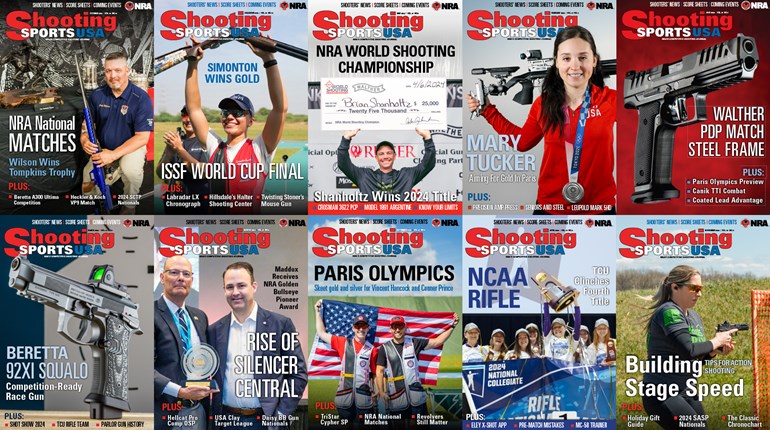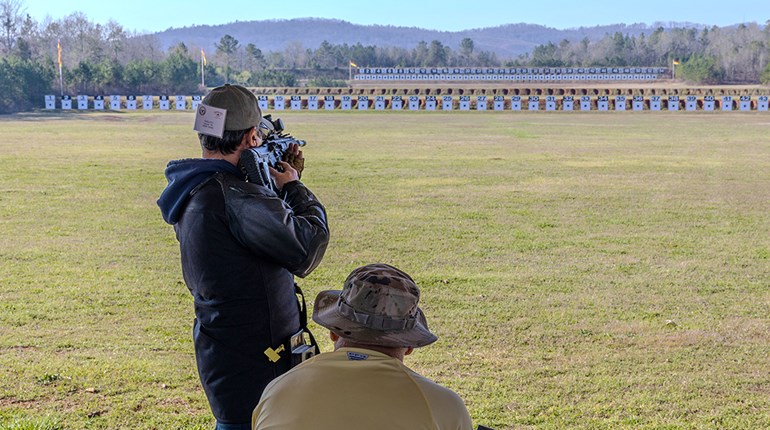
“Are you serious? You can teach me to shoot?” I still remember my friend Kai asking me incredulously.
“Yes,” I laughed. It seemed as if I had promised to make pigs fly. I just started college at Case Western Reserve University in Cleveland, Ohio this past year and had never realized how many teenagers are interested in marksmanship, but do not have any opportunity to pursue it.
I am nearing the end of my tenure as a “junior” shooter, a shooter under 21. Being a junior shooter is incredibly rewarding and economical. I have found amazing support from various clubs and programs as well as coaching and mentoring. The shooting sports community is incredibly close-knit, but junior programs are especially formative as it unites kids with the same interests at a young age. The South Cuyahoga Sportsmen’s Association’s Junior High Power Rifle Team shoots high power service rifle in the summer, and cross-trains with three-position smallbore .22 at North Olmsted Sportsman’s Club in the winter. They invite all juniors to come learn firearm safety and marksmanship. Most new kids that come are approximately 12 or 13—and this point, these kids have nearly a decade of junior training and support as they pursue various shooting endeavors.
By the time kids attend college, some former juniors give up shooting because of lack of time, range availability or funds. Those who never had the chance to participate in junior programs are nearly “aged out” of the program by the time they learn of them, if they learn of them at all. I find it incredibly disheartening that so many people, of all ages, are so quick to condemn all firearms due to ignorance. When I learned that Kai was interested in learning, I was determined to teach him.
I invited him to North Olmsted Sportsmen’s Club for a junior practice and soon found myself with four other students desiring an invitation. I knew them, and, after talking with my coaches, we made plans for them all to attend.
Over two sessions, six college students learned the basics of marksmanship. Two had never shot before, three had very limited exposure, and one had only shot casually. When they first arrived, they had a lesson on firearm safety, learned how to use a rifle sling, how to load and unload a .22 rifle, and the basics of the prone, sitting and standing positions. The club provided equipment, rifles and ammunition. The juniors each shot three A-17 targets at 50 feet, one at each position.
Following rifle practice and the comparison of scores among the group of friends, we had the opportunity to shoot handguns. A safety brief and demonstration on pistol shooting was given before everyone took turns with firearms, including a .22 revolver and a 9mm Glock.
Jakob Woerner, from a suburb of Chicago, had the most to say about the experience. When deciding to go shooting, he did so out of curiosity, as it was “something cool from the movies.” Jakob soon learned, however, that shooting well is not as easy as it looks. He “didn’t realize how many different variables there are.” Sling tension, arm position, lighting, stock placement and cheek weld are only a few of the many factors that one attempts to keep constant while shooting. Jakob had never shot before and attributed his lack of opportunity to “location…but also stigma.” In and around Chicago, as with many places around the world, there is a negative stigma towards the National Rifle Association and firearms in general. Jakob grew up without much of an opinion, not having researched the subject, but after attending NOSC, Jakob emerged with a different perspective. In a humbling moment, Jakob told me “The fact that the NRA can support that excitement and support someone like you entirely changed what I thought about the NRA.”
I really took this statement to heart and appreciated that my friend understood what makes me happy. It is infinitely rewarding to introduce someone to your passion and help them find theirs. Whether it is the same as yours or not, it is still a journey.
Rex Weinstein of New York City had an incredible amount of natural talent, but not much inclination to continue in the shooting sports. Rex enjoyed the experience, and though he has had opportunities to shoot, he was not always the most inclined to take advantage of them—hunting, in particular, didn’t interest him. Even so, Rex plans to go again with friends for what he calls “casual fun,” shooting without the stress of competition.
Darren Lau, of Hong Kong, also particularly appreciated the club atmosphere. On practice nights in the winter, the junior coaches and their wives prepare dinner. While we shoot, the adults who are not coaching generally talk and visit. The uniting factor is their love of shooting and marksmanship. Some of my coaches have been friends for decades and used to compete with one another. Now they spend their time with family and passing on what they know to the next generation of shooters. Darren gained a greater understanding of and appreciation for shooting from the event. He noted that shooting is “very mentally demanding,” but enjoys the challenge it poses. He plans to continue in the shooting sports, not necessarily as a dedicated competitor, but as an interested individual looking to improve his abilities and expand his knowledge. He would like to have the chance to try long-distance shooting and to shoot at moving targets.
Nearly everyone expressed a greater comfort with firearms after holding and operating a rifle for themselves and undergoing an extensive safety brief before shooting. Darren noted that it “has alleviated many negative connotations or impressions of firearms,” while Jakob found the extensive safety precautions and time spent teaching safe handling practices comforting. Everyone was there to help, have fun, and keep everyone safe. College is supposed to be about experimentation, learning and new opportunities. Firearm safety and an introduction to the shooting sports should be one of them.






































